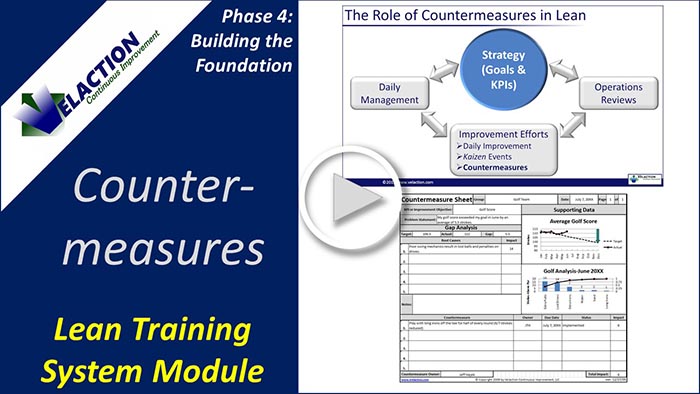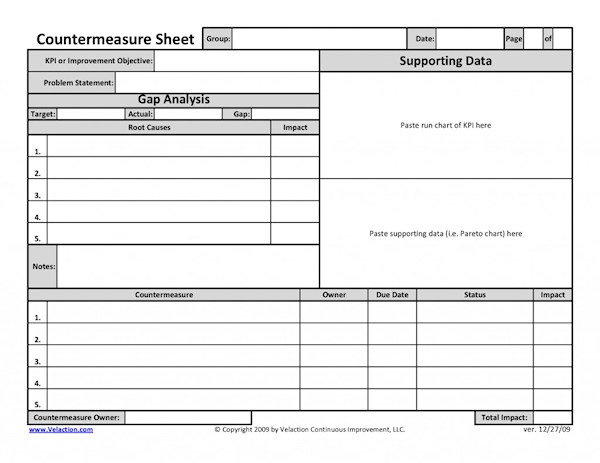| 🔍 > Lean Terms Directory |
Countermeasures
Countermeasures are the actions taken to reduce or eliminate the root causes of problems that are preventing you from reaching your goals. In many cases, this is a formal process for a company. A company does its strategic planning, which cascades down through the levels of an organization, creating targets, or Key Performance Indicators (KPIs). When the organization is missing on one of its KPIs, its leaders should perform countermeasures to make sure they have a plan to get back on track.
Countermeasures are also done when a problem pops up. When this does occur, be sure to investigate whether the issue is already linked to a company metric. You’d be surprised how often these sorts of issues can be tied to existing company targets.
Watch Our Countermeasures Video

Countermeasuring works best when it is done as a part of a formal process. You should use a standard template for the entire organization, as it provides an efficient form of communication. Anyone who knows the format can immediately understand what is happening anywhere in the organization. The A3 format is a common countermeasuring template. We also offer our own countermeasure sheet.
At a minimum, the countermeasure should include:
- A summary of the organization’s performance toward the goal
- A definition of the goal (including how the goal is measured)
- A problem statement
- A root cause analysis of each problem (with an understanding of how it contributes to the shortfall)
- An action plan that includes: task, deadline, person responsible, impact on the goal.
Countermeasures should be maintained for as long as the team is missing on its goals. In many organizations, countermeasure status is reported in monthly operations reviews.

Words of Warning About Countermeasures
- Because countermeasure sheets are generally produced with Excel and maintaining them can be math intensive, many people do not have skills that are refined enough to put together a thorough analysis. They also get so wrapped up in fighting the daily fires that they have no time left to properly manage the problems the business is facing.
- Managers want to make sure that operations reviews go well, so they do their countermeasures themselves. This prevents full buy in from their team, and also limits junior leaders’ development.

If you take the time to set goals, and you certainly should, then you should also invest the time to manage your business towards meeting those goals.
My observation is that people struggle with the process of managing their countermeasures. They look at formal countermeasures as a nuisance and do their countermeasure sheets in the last few days, or even hours, before an operations review is scheduled.
So instead of closely managing their improvement efforts, they rely on a certain amount of faith that improvement efforts are lining up with goals. Then they just pencil whip the communication aspect of their problem solving right before a meeting. When that faith is misguided, the gap between actual performance and the target didn’t close. That means wasted effort. It also puts leaders in a challenging position when it is their turn to update the organization at the ops review and they cannot show substantial progress.
Coaching and Countermeasures
It takes a lot of practice and effort to really get good at countermeasuring. As a leader, you have to stress to your team the importance of countermeasures. That means looking at the progress of improvement efforts with them more than once a month. It means providing training to them frequently and coaching them on how to improve their countermeasuring skills.
I recommend doing the coaching in private, as junior leaders and team members are not used to being scrutinized in public.
![]()
Identify a metric that is below its target and start using countermeasures on it. Once you’ve tried it for a while, find a mentor who can help you answer any questions that come up. Trying it on your own first will help you get perspective and will prepare you to ask better questions of your instructor.
![]()
Download our free countermeasures sheet to start putting this great continuous improvement tool to work.


0 Comments